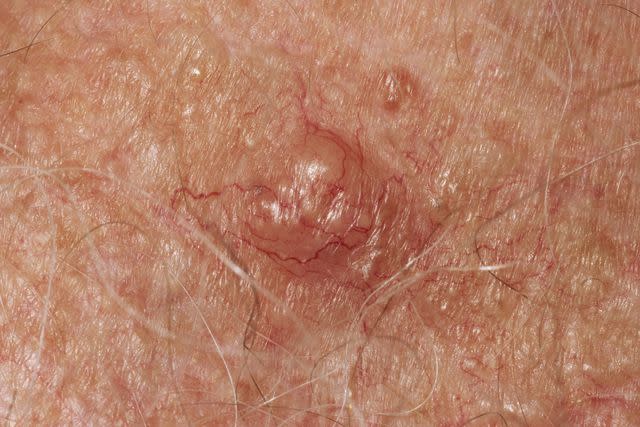What Is Sebaceous Hyperplasia?

LumiNola / Getty Images
Medically reviewed by Casey Gallagher, MD
Sebaceous hyperplasia is a common skin condition where the glands that make oil for the skin are bigger than usual. It can cause bumps on the skin that are usually flesh-colored and smooth or slightly uneven and coarse to the touch. The bumps are often caused by blocked hair follicles.
Sebaceous hyperplasia usually does not go away without treatment, but the bumps are also harmless and don't necessarily need to be treated. Sebaceous hyperplasia is not contagious.
This article reviews the symptoms and causes of sebaceous hyperplasia. It also looks at the ways it can be distinguished from certain types of skin cancer. You'll also learn about various treatment options.

LumiNola / Getty Images
Sebaceous Hyperplasia Symptoms
Sebaceous hyperplasia can appear as a single bump or multiple bumps in a cluster or line. The bumps range from 1 or 2 mm to several millimeters in size. They are often the same color as your skin but may also look white to slightly yellow.
The bumps don't hurt or itch. They may bleed if you knock them or shave over them, though.
Sebaceous hyperplasia most often develops on the face. The most common places to find them are the forehead, cheeks, and nose. Babies often have bumps on the upper lip. Uncommonly, the bumps can appear in other places, such as:
Back and chest
Shoulders
Areola, the darker skin surrounding the nipple
Penis
Scrotum
Vulva
Sebaceous hyperplasia bumps don't usually go away on their own. One exception is newborns. Their bumps usually disappear within a few months.
Acne or Sebaceous Hyperplasia?
Because the bumps look similar to non-inflamed acne breakouts, the condition is sometimes confused with comedonal acne.
If you look closely, though, you may see a depressed or pitted area in the center of the bump. You may also be able to see tiny blood vessels inside. These are clues you're not dealing with acne.
Related: Sebaceous Glands and Your Skin
What Causes Sebaceous Hyperplasia?
Sebaceous hyperplasia bumps are not rashes or growths. Rather, they are enlarged sebaceous glands. These are tiny glands under the surface of the skin. They are present all over the body, except for the palms and soles of the feet. They produce an oil called sebum. This oil keeps skin lubricated and healthy.
Sebaceous hyperplasia is caused by an overabundance of sebocytes. These are special cells that make up the sebaceous glands. The excess cells enlarge the sebaceous gland, making it grow several times larger than normal.
Several factors can contribute to sebaceous hyperplasia. The biggest one is hormone changes. There also seems to be a genetic link. If someone in your family has sebaceous hyperplasia, you're more prone to developing it too.
In some cases, sebaceous hyperplasia may be linked to sun exposure.
Hormones
Androgens are male sex hormones. These hormones, especially testosterone, stimulate sebaceous glands to create more oil. Their role is very evident during puberty, when a large increase in androgens leads many teens to have very oily skin.
With age, androgens decrease. This slows sebaceous gland activity and oil production. Cell turnover slows down as well. This is the rate at which dead cells in the sebaceous glands are replaced with fresh ones. The dead cells back up within the gland, causing it to enlarge.
Related: Hormonal Acne: What You Should Know
Risk Factors
Sebaceous hyperplasia is more common as you get older. It doesn't usually appear until middle age or later. The condition affects both men and women about equally. It's seen most often in people with light or fair skin. Some people with a family history of sebaceous hyperplasia may get it at a much earlier age, though this is rarer.
Long-term use of the immunosuppressive drug cyclosporine has also been linked to sebaceous hyperplasia. People who have had transplants and are taking this drug are more likely to develop the condition.
Newborns often develop the condition, too. This is because of hormones passed from mother to child. In babies, sebaceous hyperplasia often appears alongside baby acne.
Diagnosing Sebaceous Hyperplasia
Your healthcare provider can usually diagnose sebaceous hyperplasia with a simple visual inspection. If there's any question about the diagnosis, though, they may order a skin biopsy. This will help rule out other conditions like skin cancer.
Sometimes it can be hard to tell the difference between sebaceous hyperplasia and a skin cancer called basal cell carcinoma. Basal cell carcinoma often appears on the head or neck. It looks like a shiny, raised, and round pimple, scar, or sore.

Science Photo Library / Getty Images
Basal cell carcinomaA biopsy can also help rule out sebaceous gland carcinoma. This rare, slow-growing cancer appears as a firm, yellowish lump. It often appears on the eyelid, and it may bleed and look like a pimple or sore that doesn't heal. It may also heal and then reappear.
Muir-Torre syndrome is a rare inherited disease. It is a variant of Lynch syndrome. Patients with this condition at higher risk for developing sebaceous gland carcinoma.
Related: Types and Prevention of Skin Cancer on the Face
How to Get Rid of Sebaceous Hyperplasia
There is no medical need to treat sebaceous hyperplasia. Adults may choose to treat the bumps for cosmetic reasons. It's also fine to just let them be.
You can't squeeze sebaceous hyperplasia bumps. This is because there isn't anything inside that can be extracted. In fact, squeezing them can actually cause them to become inflamed or bleed.
There are a few treatment options available. Your results will depend on factors such as:
The number of bumps you have
Your age
Your skin type
How your skin reacts to sun exposure
Prescription Medications
Prescription medications may help keep new bumps from forming. Options include:
Azelaic acid
These medicines speed up the skin's natural cell turnover rate. They may also make existing bumps appear smaller. These topical treatments probably won't get rid of all your bumps, though.
If you have a severe case, your healthcare provider may prescribe Accutane (isotretinoin). This is an oral medication that shrinks sebaceous glands. This treatment is effective, but bumps may return after the medicine is stopped. Accutane also cannot be used during pregnancy.
Finally, antiandrogen medications can be used in women with the condition. These include:
Certain birth control pills
Aldactone (spironolactone)
These medications block the effect of testosterone on the skin.
Procedures
There are also several in-office procedures that treat sebaceous hyperplasia. These treatments often provide faster and more obvious improvement. Still, there is a risk of skin discoloration or scarring. The condition may also recur after the procedure.
Options include:
Laser resurfacing: A laser delivers a wavelength of light into your skin. The light targets, heats, and destroys enlarged sebaceous glands.
Photodynamic therapy: A chemical substance that absorbs light is applied to your skin. Then, light treatment is used to reduce the number and size of sebaceous glands.
Cryotherapy: Liquid nitrogen is sprayed onto the affected area of the skin. This freezes the bumps so they dry up and fall off.
Cauterization or electrodesiccation: A sharp needle is heated with an electrical charge. When inserted into a bump, the bump rapidly dries up.
Excision: Bumps are shaved or cut out.
Several types of lasers are used to treat sebaceous hyperplasia. Based on research, the most effective ones include:
The er:Yag laser
The pulse dye laser
The 1450-nm diode laser
The CO2 laser
Related: The Lowdown on Laser Skin Resurfacing
OTC Medications
Some over-the-counter (OTC) remedies include:
OTC face washes or peels containing salicylic acid
Facial creams that contain retinol
There is no scientific evidence that these products work for sebaceous hyperplasia. When used as directed, though, there is no harm in trying.
Related: What to Expect From a Salicylic Acid Peel
Home Remedies
A warm compress may help reduce the size of the bumps and any inflammation you may have. It won't help them go away, though.
Sun exposure may play a role in the development of sebaceous hyperplasia. Daily application of sunscreen with an SPF of a least 30 may help prevent the onset or worsening of the condition.
Summary
Sebaceous hyperplasia is characterized by the formation of small, painless bumps. The bumps appear on parts of the body where many oil glands are found, like your face.
This harmless skin condition can usually be diagnosed with a simple visual inspection. Sometimes a biopsy is performed to rule out skin cancer.
Treatment for sebaceous hyperplasia is for cosmetic purposes only.

